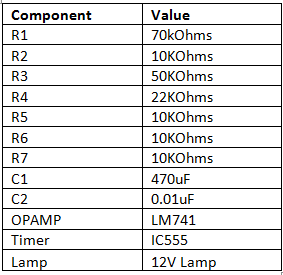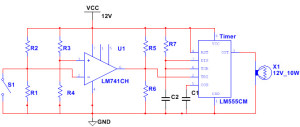Automatic Washroom Light
Automatic Washroom Light
Have you ever thought of any system ever existed that is capable of switching on the lights of your washroom the moment you enter into it, and switching off the lights when you leave the bathroom?
Is it really possible to switch on the bathroom lights by just merely entering the bathroom and switch off by just leaving the bathroom? Yes, it is! With an automatic home system you don’t really need to press any switch at all, on the contrary, all you need to do is open or close the door – that’s all. In order to get such a system all you required is a normally closed switch, an OPAMP, a timer and a 12V lamp.
Components Required
Circuit Connection
The OPAMP IC 741 is a single OPAMP IC consisting of 8 pins.The Pins 2 and 3 are the input pins while the pin 3 is a non-inverting terminal, and the pin 2 is an inverting terminal. A fixed voltage through a potential divider arrangement is given to the pin 3,and an input voltage through a switch is given to the pin 2.
The switch used is normally closed SPST switch. The output from the OPAMP IC is fed to the 555 Timer IC, which if triggered (by a low voltage at its input pin 2), generates a high logic pulse (with the voltage equal to its power supply of 12V) at its output pin 3. This output pin is connected to the 12V lamp.
Circuit Diagram
Circuit Operation
The switch is placed on the wall in such a way that when the door is opened by pushing it completely towards the wall, the normally closed switch gets opened when the door touches the wall. The OPAMP used here works as a comparator. When the switch is opened, the inverting terminal gets connected to the 12V supply, and a voltage of approximately 4V is fed to the non- inverting terminal.
Now, the non-inverting terminal voltage being lesser than that at the inverting terminal, a low logic pulse is generated at the output of the OPAMP. This is fed to the timer IC input through a potential divider arrangement. The timer IC gets triggered with a low logic signal at its input and generates a high logic pulse at its output. Here, the timer works in a mono- stable mode. When the lamp receives this 12V signal, it glows.
Similarly, when a person comes out of the washroom and closes the door, the switch gets back to its normal position and gets closed. Because the non-inverting terminal of the OPAMP is at a higher voltage compared to the inverting terminal, the output of the OPAMP is at a logic high. This fails to trigger the timer; since there is no output from the timer, the lamp gets switched OFF.v


Comments
Post a Comment